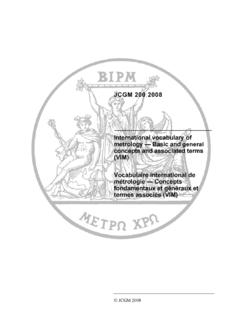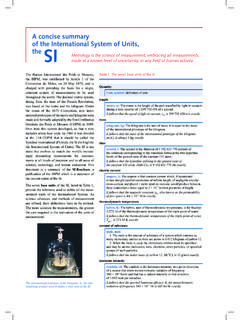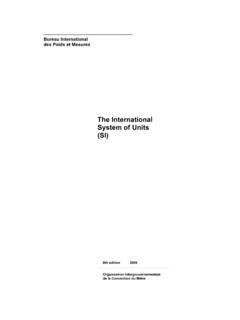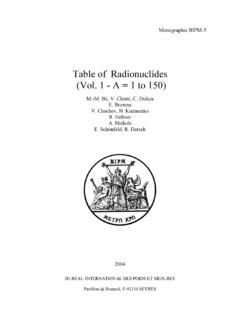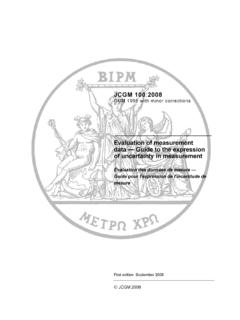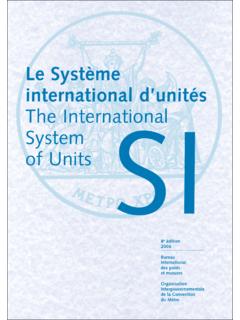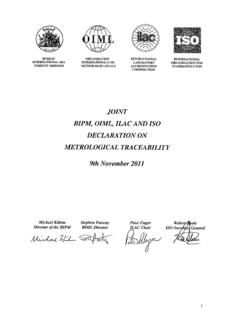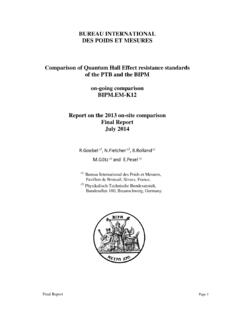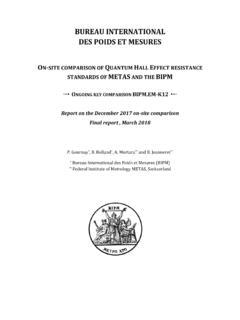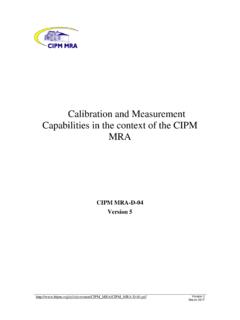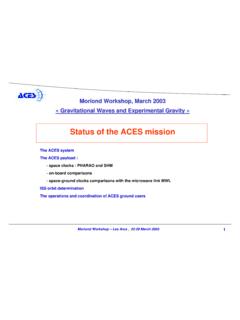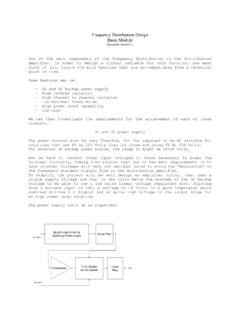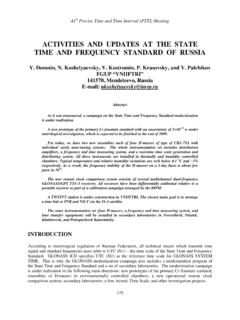Transcription of Report of the NRC to the 19th Session of the CCTF
1 cctf /12-34. Report of the NRC to the 19th Session of the cctf . Frequency and Time Group, Measurement Science and Standards, National Research Council, Ottawa, Canada September 7, 2012. Report from NRC to the 19th Session of the Consultative Committee for Time and Frequency ( cctf ), 12th-14th September 2012. 1. Introduction This Report describes the activities of the National Research Council of Canada in time and frequency metrology since the last cctf meeting. The Report is divided into three sections on Time and Frequency Generation, Time and Frequency Standards in Development, and Time Comparison and Dissemination. 2. Time and Frequency Generation An Agilent 5071A is the source of TA(NRC). UTC(NRC) is generated by the same clock using a frequency offset generator to track UTC within 100 nanoseconds. Three NRC. 5071A clocks are reported to the BIPM for contribution to TAI. Four 5071A clocks and two hydrogen masers are reported to the BIPM for the Rapid UTC pilot project.
2 In the last few years we have dramatically improved the temperature control in the NRC. time labs. New air conditioning systems were installed in December 2010. The temperature stability in the clock rooms and the measurements lab in the last year was typically within C. An on-going optimization of the system performance is under way. Caesium Clocks: A total of six commercial clocks (Agilent 5071A) are available. We run four commercial clocks simultaneously: three provide a reliable source for UTC(NRC) and the fourth is a backup under evaluation. Two NRC built clocks, CsVIa and CsVIc, are under refurbishment and are expected to come online in the next year and replace two of the commercial clocks in the ensemble. An additional low performance Agilent 5071A clock is in operation at the short wave radio station (CHU). Hydrogen Masers: Three hydrogen masers are in use: NRC-built H4 (provides a local oscillator reference for the GPS receivers); Kvarz CH1-75A; and a newly purchased (March 2012) Symmetricom MHM-2010.
3 Frequency Measurements of Molecular Transitions: Since 2009, absolute frequency measurements (five in total) have been performed of the two 193-THz ( m) NRC. reference laser systems stabilized on component P(16) of the band of 13C2H2. Additional absolute frequency measurements (nine in total) have been performed for the group's three iodine stabilized 474-THz (633-nm) HeNe lasers for the reference f or a16 component of the R(127) line in iodine. All systems continue to operate within the specified accuracy and long-term reproducibilities at the kilohertz level are achieved for these standards. Phase comparators : We currently use 5 MHz NRC-built phase comparators and a refurbished 80-MHz phase comparator from timetech . 100-MHz NRC-built phase comparators are under development. Time Interval Counters: We operate two HP 5370B counters that are part of our system. We plan to replace these with Pendulum CNT 91 counters in the near future. Frequency combs: Two frequency combs are in use in our laboratory.
4 A Ti:sapphire comb is used in calibrations of optical frequency/wavelength for standard lasers in our group (I2/HeNe at 633 nm and acetylene-stabilized lasers in the region of 1540 nm), and for lasers belonging to the Length Standards Laboratory (544 nm, 612 nm and 1153 nm). A fibre comb is used for the measurements of the clock transition frequency at 445 THz (674 nm) of the single strontium ion standard against the hydrogen maser H4, thus providing a link to TAI. A second 100-MHz frequency comb is under construction to be used as a source of rf signals for direct comparison with microwave standards. 3. Time and Frequency Standards in Development Cesium Fountain: The NRC-FCs1 cesium fountain frequency standard utilizes a magneto-optical trap and a transversal C-field. The fountain is currently under evaluation. The C-field has been mapped in the drift region [1] with a resulting contribution to the frequency uncertainty at the level of 2 10-16. The detection system was recently modified to reduce background noise on the measurements of the number of atoms.
5 The remaining tasks are to measure the magnetic field above the state-selection cavity, measure frequency shifts as a function of tilt, launch angle, microwave power, number of atoms, evaluate the background light shifts and complete a theoretical model of the cavity shifts. The expected uncertainty level is at 1 10-15. Sr ion Standard: A new improved Sr+ optical frequency standard system has been built and is currently being evaluated. The system includes a new endcap ion trap designed to control micromotion shifts down to corresponding frequency uncertainty levels of 10-18. The total fractional frequency uncertainty of the trap, dominated by blackbody radiation, is estimated at 2 10-17 [2]. Based on a two month measurement campaign to determine the ion centre frequency, optical frequency comb measurements referenced to an NRC H. maser system were performed. The final result of the measurements yielded: FS-D = 444 779 044 095 Hz (1 ) 5s 2S1/2 4d 2D5/2 , 88Sr+.
6 Ultra stable lasers: The 674 nm ULE laser linewidth has been demonstrated to be below Hz and its thermal noise is at the level of 10-16. The lock stability of the ULE to the Sr ion is 1 10-14 -1/2. 4. Time Comparison and Dissemination GPS: GPS common-view is used to compare UTC(NRC) with other clocks around the world. We currently operate Ashtech Z-12T (official link with BIPM), Topcon NET-G3A. and Novatel OEMV and OEM4 receivers at our main campus and Novatel OEMV and OEM4 receivers at our shortwave broadcasting facility (CHU). We participate in TAIPPP. and Rapid-UTC projects at BIPM and in SIM time and frequency comparison. CMC: Calibration and Measurement Capabilities, CMC, for Time and Frequency have been successfully externally peer-reviewed by MIKES in July 2011. We participate in the international key comparisons: (ongoing), CCL-K11 key comparisons of optical frequency/wavelength standards (Sept. 2009 and Aug. 2012) and SIM organized stopwatch comparison (May 2010 to Feb.)
7 2011). Time Dissemination: Time is disseminated continuously through a telephone talking clock, computer time code via telephone, a web clock, network time protocol, shortwave radio broadcasts from CHU and on the national broadcaster, CBC/Radio-Canada. For a listing of our services, see and Low-level calibrations are routinely performed for stopwatches and quartz crystals. High level calibrations for Cs and Rb frequency standards as well as H masers are performed as a routine service. Calibrations of laser frequency/wavelength are offered for wavelengths from 530 to 1200. nm and from 1510 to 1560 nm. For redundancy purposes, the NRC time dissemination lab has a secondary remote location at the CHU facility. At that location one low performance Agilent 5071A clock and two commercial rubidium standards (HP 5065 and Symmetricom 8040C) along with two GPS receivers (Novatel OEMV and OUM4) are in operation and provide a backup for time dissemination services and the NRC time scale.
8 1. M. Gertsvolf and L. Marmet, IEEE IFCS-EFTF 2011, 52; M. Gertsvolf and L. Marmet, Rev. Sci. Instrum. 82, 123115 (2011),; doi: 2. P. Dube et al, Proceedings of IEEE IFCS 2012, 7138; A. A. Madej et al, Phys. Rev. Lett. (submitted) (2012).
